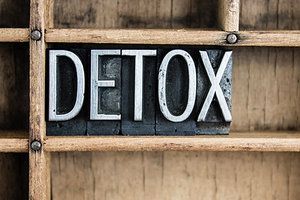One of the longest nerves in the body is known as the vagus nerve (VN). The VN is the 10th pair of cranial nerves that originates at the brain stem in the medulla oblongata. This nerve is part of the parasympathetic nervous system, which is a part of the ANS. Research suggests ear acupuncture can activate the VN.
Heavy-Metal Detox: Herbal Solutions
The heavy metals most commonly associated with poisoning of humans are arsenic, cadmium, lead and mercury. The World Health Organization has expressed concern about these heavy metals as potentially harmful to human health due to the fact that exposure is ubiquitous and can affect the human brain, kidneys and heart – even at very low levels. Heavy-metal poisoning may occur as a result of industrial exposure, air or water pollution, foods, medicines, improperly coated food containers, or lead-based paints.
Toxic metals compete with and replace certain essential minerals, which affects several organ systems. Symptoms of heavy-metal poisoning include sensory impairment (vision, hearing or speech), poor coordination, peripheral neuropathy (tingling, itching, burning or pain) skin discoloration (pink cheeks, fingertips and toes), swelling, and shedding or peeling of skin.
Arsenic
Arsenic can impair cellular respiration by inhibiting mitochondrial enzymes, causing uncoupling of oxidative phosphorylation leading to cell death. Inorganic arsenic can be methylated inside the body to become carcinogenic by causing DNA methylation.1-2
Cadmium
Cadmium can induce ROS production, causing depletion of glutathione (GSH), which results in oxidative stress, causes mutations and chromosomal deletions, and induces apoptosis. At low concentrations, cadmium binds to mitochondria and inhibits both cellular respiration and oxidative phosphorylation.3

Cadmium is especially toxic to the kidneys, which hold 50 percent of the total body burden. Once cadmium enters the body, much of it is bound to metallothioniens. These compounds are cleared through the glomeruli, but are then reabsorbed by the tubules, where they become stuck.
As the metallothioniens slowly degrade, highly toxic free cadmium is constantly released. Although it then passively migrates into the urine, it causes oxidative stress to the tubules, leading to kidney degeneration and loss of function. The cadmium damage to the kidneys helps explain why it accounts for a surprising 20 percent of osteoporosis.
Lead
Lead is a cumulative toxicant that affects multiple organs including the brain, liver, kidneys and bones; and is particularly harmful to young children. It is accumulated in the teeth and bones over time and released into the blood during pregnancy, affecting the developing fetus. The level of exposure is usually assessed through the measurement of lead in the blood.
The primary target of lead is the central nervous system. Its neurotoxicity is the induction of oxidative stress and intensification of apoptosis of neurocites, interfering with calcium-dependent enzymes like nitric oxide synthase.4
Mercury
Chronic exposure to mercury can damage the nervous system, brain and kidneys. Common symptoms are irritability, shyness, tremors, vision and hearing problems, and memory deficits.
Mercury exists in multiple oxidative states, as inorganic salts, and as organic complexes. Mercury ions can cause protein precipitation, enzyme inhibition and generalized corrosive action. Mercury binds to proteins (including enzymes) and renders them inactive.
Mercuric salts that are divalent are more soluble and more rapidly absorbed; therefore, they are more toxic than monovalent mercurous salts. However, organic mercury is even more toxic because only about 10 percent of inorganic mercury salt (regardless of the oxidative state) is absorbed via the GI tract, compared to 90 percent of the organic form.5
The highest accumulation of inorganic mercury is in the kidneys, because the kidneys have a high affinity for them. In fact, within a few hours of exposure, 50 percent of the mercury salt that gets into the blood ends up in the kidneys, and can cause damage to both the glomeruli and the tubules.
Excretion of Heavy Metals
The liver plays a key role in the body's detoxification of heavy metals. Among the liver's various detoxification pathways, the glutathione pathway is particularly crucial for heavy-metal detoxification including cadmium, lead and mercury. Glutathione has a high affinity with heavy metals and functions as a chelating agent to form a conjugator, which is then transported with bile to the GI tract to be excreted as stool.6 While in arsenic detoxification, the conjugator will be further methylated before exported and removed by the liver with bile.7
Besides functioning as a chelating agent, glutathione is also an antioxidant that helps remove ROS. This is important to counter the increased oxidative stress induced by heavy metals.
Glutathione is highly concentrated in the liver. However, an increase of ROS and oxidative stress resulting from heavy-metal toxicity can cause depleted glutathione in liver cells, reducing the ability to remove the heavy metals.
Wellness Recommendation
TCM herbal therapies are extremely effective for restoring liver health by supplying sufficient amounts of glutathione and aiding in successful heavy-metal detoxification.
Herbal ingredients that enhance liver qi and clear liver heat to address liver toxicity caused by heavy metals are recommended. They help support the liver's detoxification function by reducing liver inflammation and improving liver immunity. Radix bupleuri and Yunzhi, for example, have been shown to possess immune-modulating and anti-inflammatory effects with an affinity for liver cells.9,11
Other herbs that target liver and kidney yin and yang are also recommended to support the detoxification. Hawthorn fruit has been shown to increase antioxidant enzymes, namely superoxide dismutase (SOD), catalase (CAT), and glutathione peroxidase (GSH-Px) in serum, liver and the brain.7 Rhizoma alismatis addresses the structural deficiencies of the liver by increasing lipid export, controlling inflammatory markers and reducing oxidative stress levels.8 Gynostymma helps to remove toxicity and inflammation, improves lipid metabolism, and has protective effects on both the liver and kidneys.10
Case Report: Successful Resolution of Arsenic Poisoning
— Sheila LaPlante, LAc
A patient came for treatment after receiving a blood test which revealed high blood arsenic levels of 74 ng/mL. Normal levels are below 12 ng/mL. Sheila began a protocol consisting of three formulas that contained Rhizoma alismatis gynostymma, Radix bupleuri, and 13 other herbal ingredients that help the liver and kidneys.
After three months, the patient's blood tests revealed that arsenic levels had been reduced to 11 ng/mL. The patient feels better, and her symptoms of muscle fatigue and blood vessel problems have subsided.
References
- Singh AP, Goel RK, Kaur T. Mechanisms pertaining to arsenic toxicity. Toxicol Int, 2011;18(2):87-93.
- Hughes MF. Arsenic toxicity and potential mechanisms of action. Toxicol Lett, 2002 Jul 7;133(1):1-16.
- Rafati Rahimzadeh M, Kazemi S, Moghadamnia AA. Cadmium toxicity and treatment: an update. Caspian J Intern Med, 2017;8(3):135-145.
- Nemsadze K, Sanikidze T, Ratiani L, et al. Mechanisms of lead-induced poisoning. Georgian Med News, 2009 Jul-Aug;(172-173):92-6.
- Park JD, Zheng W. Human exposure and health effects of inorganic and elemental mercury. J Prev Med Public Health, 2012;45(6):344-352.
- Lawley SD, Yun J, Gamble MV, et al. Mathematical modeling of the effects of glutathione on arsenic methylation. Theor Biol & Med Mod, 2014;11:20.
- Rezaei-Golmisheh A, Malekinejad H, Asri-Rezaei S, et al. Hawthorn ethanolic extracts with triterpenoids and flavonoids exert hepatoprotective effects and suppress the hypercholesterolemia-induced oxidative stress in rats. Iranian J Basic Med Sci, 2015;18(7):691-699.
- Choi E, Jang E, Lee JH. Pharmacological activities of Alisma orientale against nonalcoholic fatty liver disease and metabolic syndrome: literature review. Evid-Based Compl Alt Med (eCAM), 2019:2943162.
- Yang F, Dong X, Yin X, et al. Radix bupleuri: a review of traditional uses, botany, phytochemistry, pharmacology, and toxicology. BioMed Res Int, 2017:7597596.
- Ye Q, Zhu YI, Ye S, et al. Gypenoside attenuates renal ischemia/reperfusion injury in mice by inhibition of ERK signaling. Exper & Ther Med, 2016;11(4):1499-1505.
- Wong CK, Tse PS, Wong EL, et al. Immunomodulatory effects of yun zhi and danshen capsules in health subjects - a randomized, double-blind, placebo-controlled, crossover study. Int Immunopharmacol, 2004 Feb;4(2):201-11.



